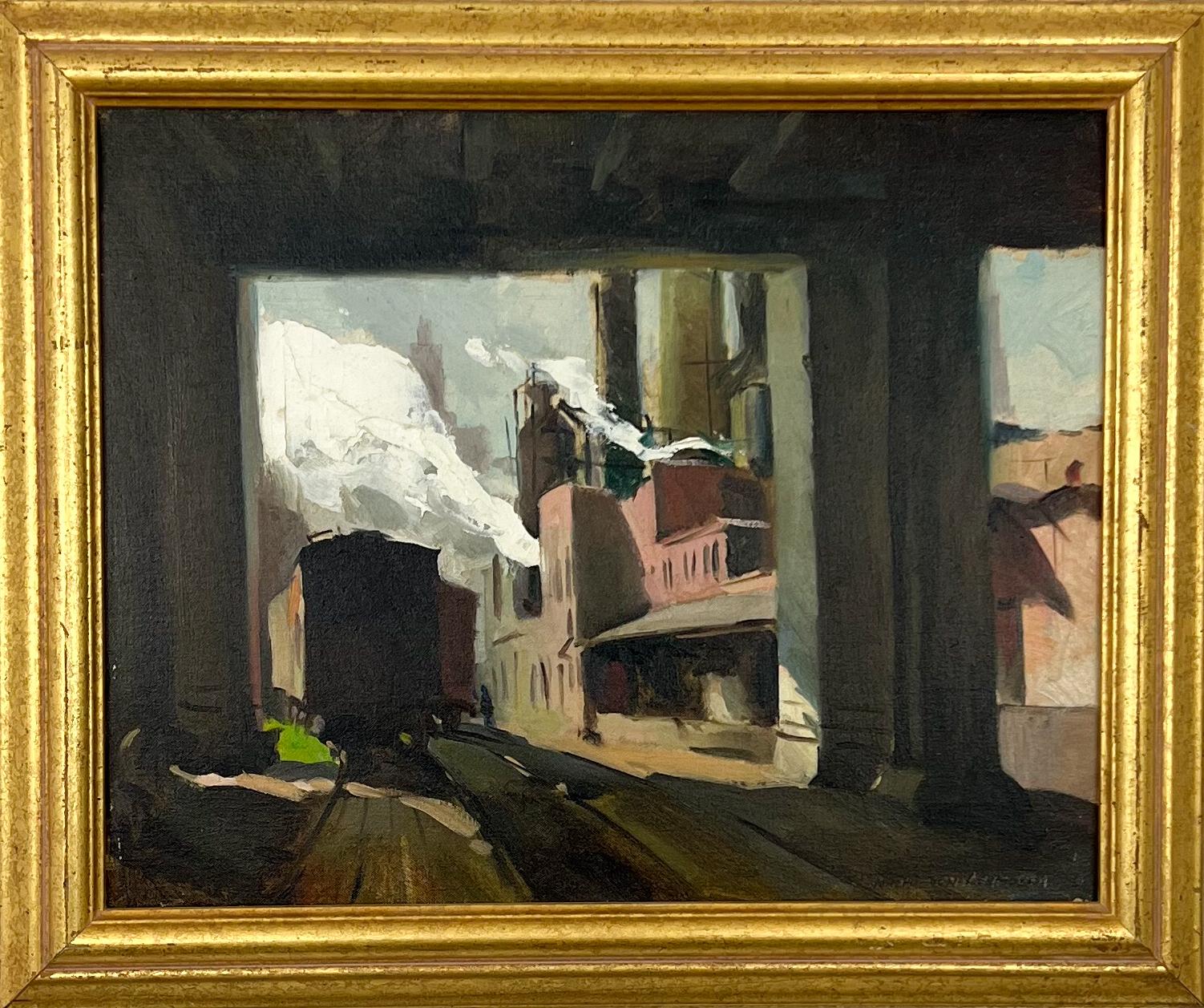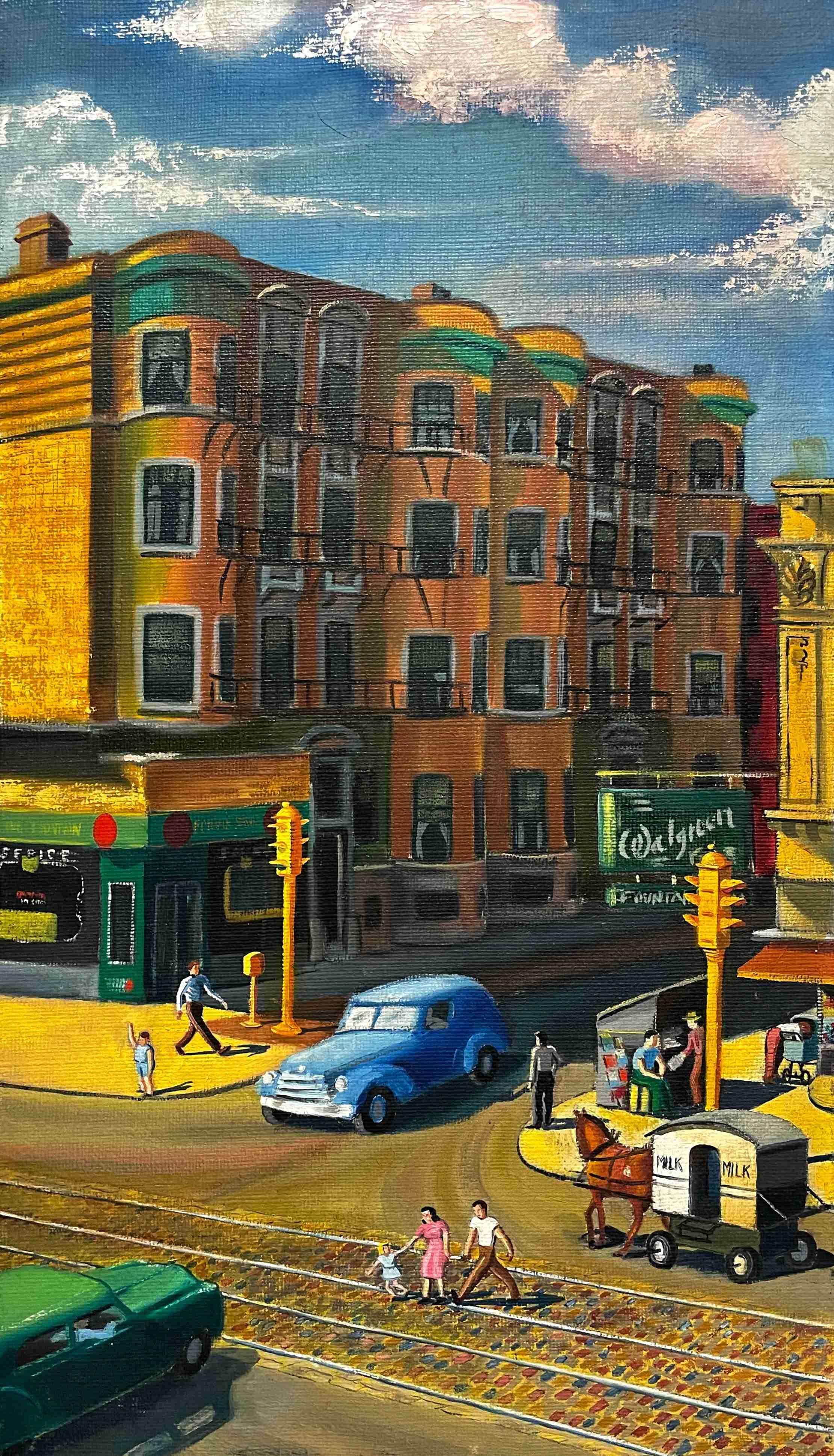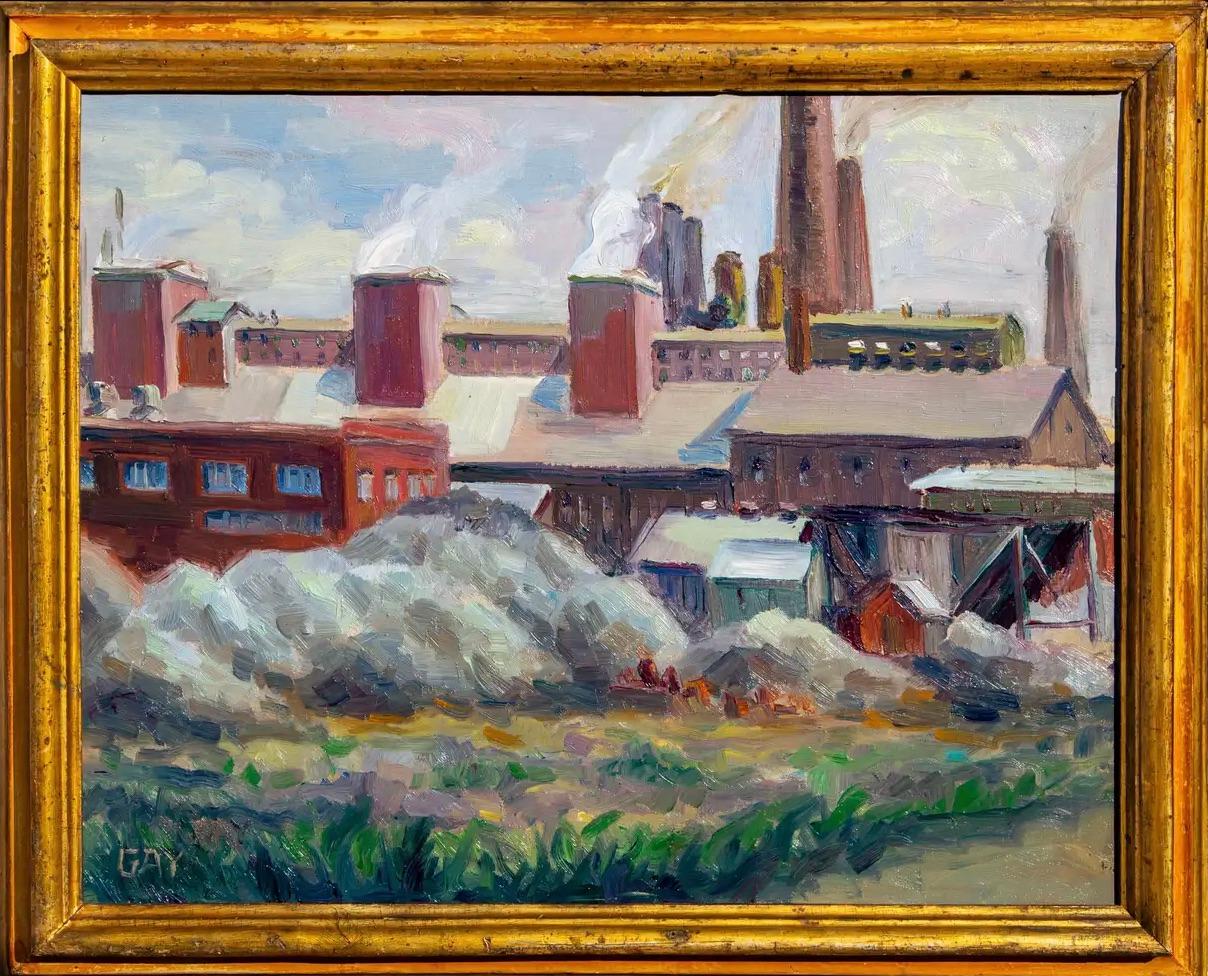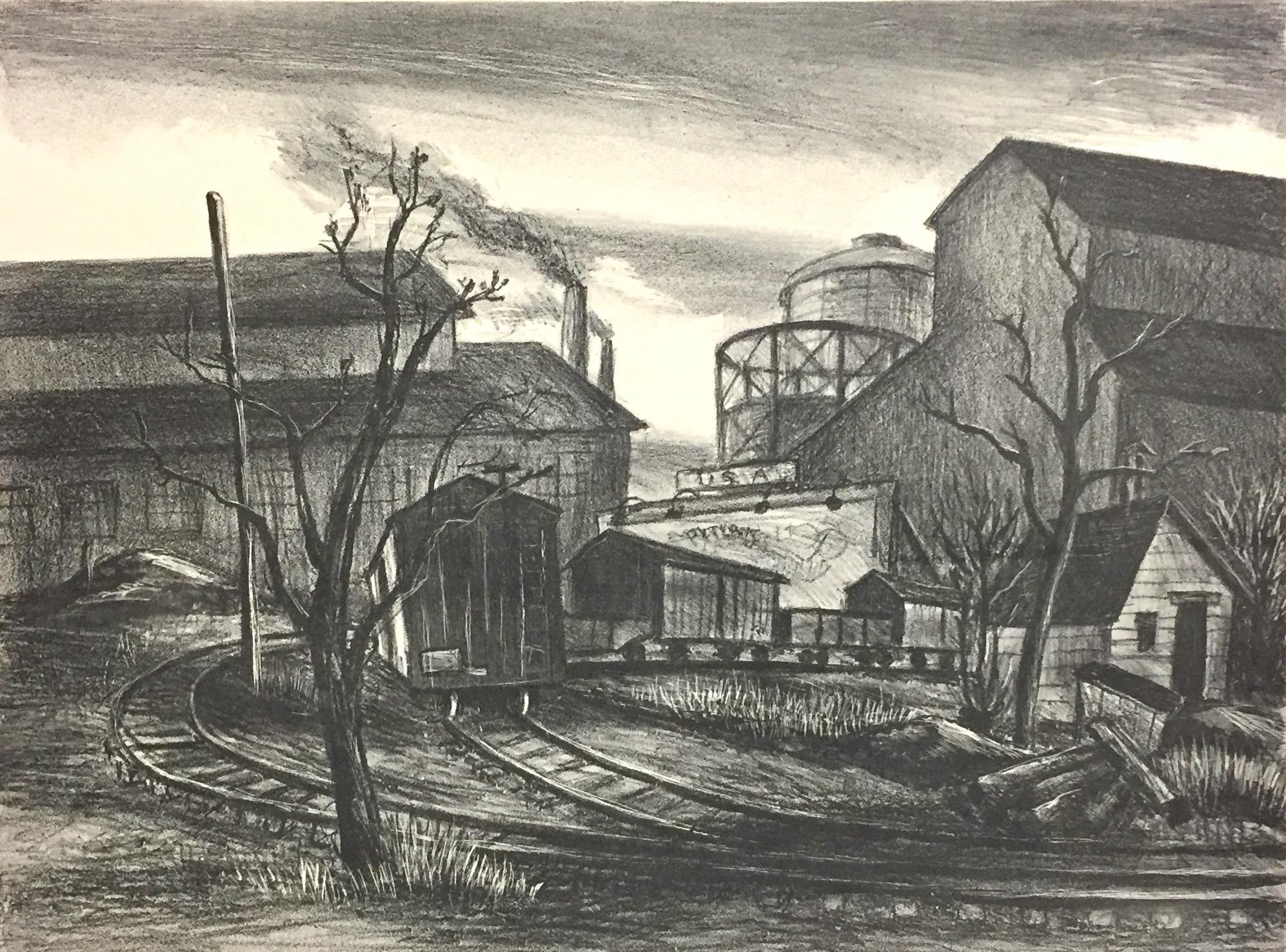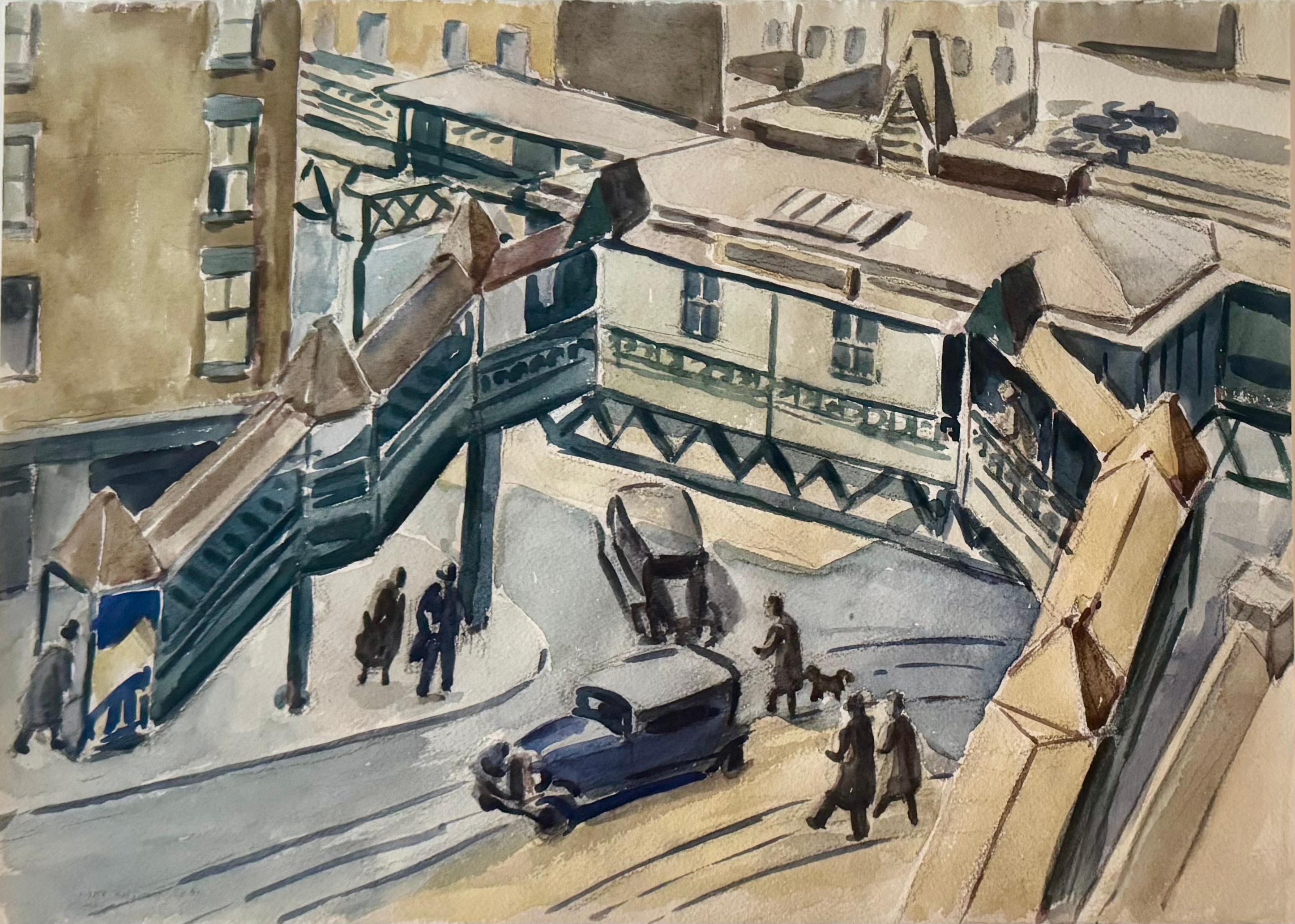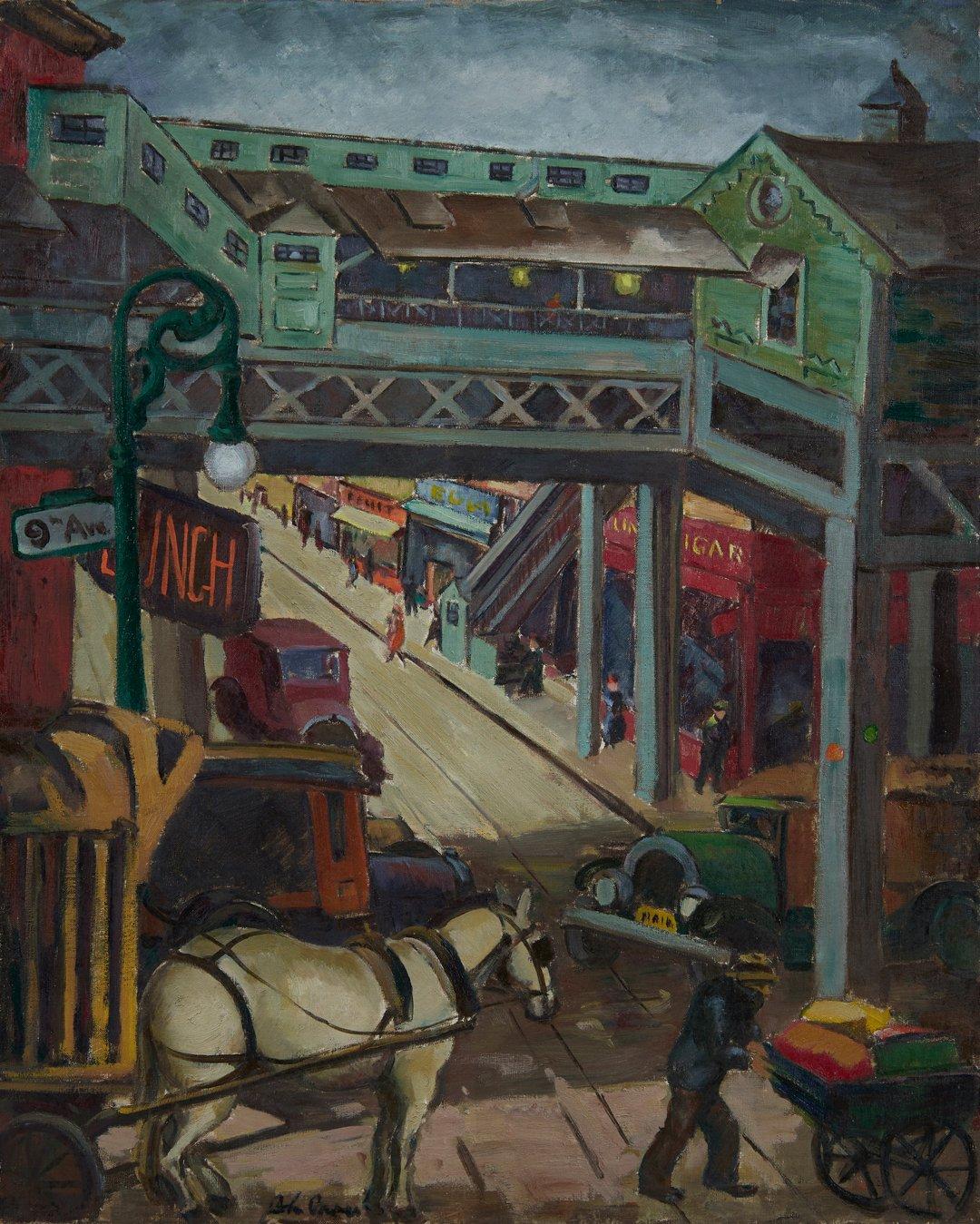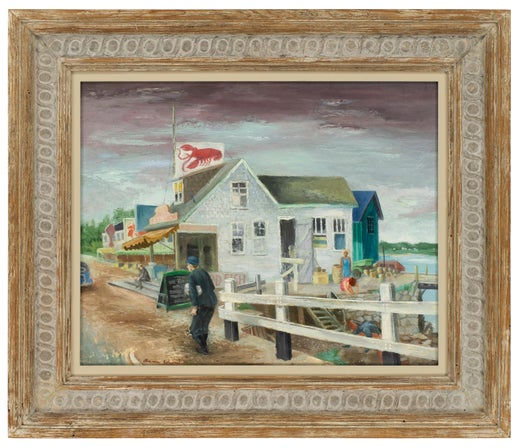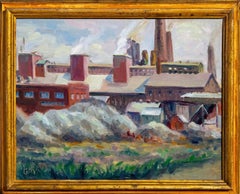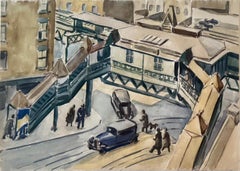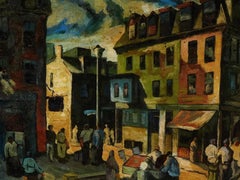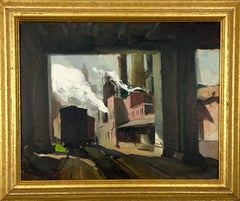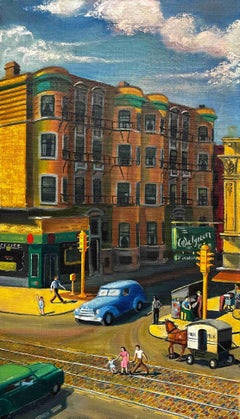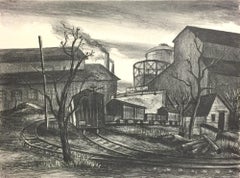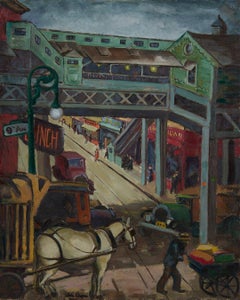Items Similar to "Industrial Cityscape, Chicago" WPA Modernism Mid-Century Cityscape 20th Century
Want more images or videos?
Request additional images or videos from the seller
1 of 8
Aaron Bohrod"Industrial Cityscape, Chicago" WPA Modernism Mid-Century Cityscape 20th Century1931
1931
$16,000
£12,140.43
€13,881.50
CA$22,347.66
A$24,847.56
CHF 12,974.02
MX$302,455.30
NOK 165,542.90
SEK 155,105.79
DKK 103,600.18
Shipping
Retrieving quote...The 1stDibs Promise:
Authenticity Guarantee,
Money-Back Guarantee,
24-Hour Cancellation
About the Item
"Industrial Cityscape, Chicago" WPA Modernism Mid-Century Cityscape 20th Century
Aaron Bohrod (American 1907 – 1992)
Industrial Cityscape
20 x 16 inches
Oil on board
Signed lower right and verso, dated 1931.
Carved vintage frame 27 x 23 inches.
BIO
Known for a range of work in watercolor and gouache that included realist figures in cityscapes, landscapes, surrealism, and trompe l'oeil painting, Aaron Bohrod spent his early career in Chicago where he was born on the West Side.
In 1948, he moved to Madison, Wisconsin, where he became a long-time a member of the art faculty and satisfied the inclinations of many artists who leaned towards European-influenced modernism. In this university position, he replaced John Steuart Curry, Regionalist painter from Kansas, who had died. Many artists led by Surrealist Marshall Glasier thought Curry had been provincial and limited in subject matter and style.
In the late 1920's, Bohrod studied at the Art Institute of Chicago and then went to New York City to attend the Art Students League. He returned to his hometown in 1930 and resided there until the move to Wisconsin.
Influenced strongly by the Social Realism of John Sloan, whom he knew from New York, Bohrod painted city people, utilizing a wide array of styles ranging from a tight, detailed manner to one that was more abstract and sketch like. One of his subjects explored in a series of paintings was the neighborhood where he grew up on the North Side of Chicago. Many of them convey the loneliness and poverty of the Depression years.
He spent some time in the South Pacific during World War II as a war artist and in Europe on assignments from "Life" magazine and from the U.S. Engineers to record the events of World War II in Normandy, Cherbourg, England, Germany and the South Pacific. His completed paintings are in the Pentagon Collection. Following this assignment, he served for one year, 1942 to 1943, as Artist-in-Residence at Southern Illinois University in Carbondale.
In the late 1940's Bohrod began working with ceramics, which he said influenced him towards surrealism with odd juxtapositions that embraced the style of trompe l'oeil (fool-the-eye). Unlike many surrealists, his work did not have nightmarish undertones. During this period, his painting became increasingly realistic.
- Creator:Aaron Bohrod (1907 - 1992, American)
- Creation Year:1931
- Dimensions:Height: 27 in (68.58 cm)Width: 23 in (58.42 cm)
- Medium:
- Movement & Style:
- Period:
- Condition:
- Gallery Location:New York, NY
- Reference Number:1stDibs: LU115625096812
Aaron Bohrod
Aaron Bohrod's work has not been limited to one style or medium. Initially recognized as a regionalist painter of American scenes, particularly of his native Chicago, Bohrod later devoted himself to detailed still-life paintings rendered in the trompe l'oeil style. He also worked for several years in ceramics and wrote a book on pottery. Born in 1907, Bohrod began his studies at Chicago's Crane Junior College in 1925, and two years later enrolled in the Art Institute of Chicago. But it was at the Art Students League in New York City, from 1930 to 1932, that he studied under the man believed to be his most significant early influence, John Sloan. Sloan's romantic realism is reflected in the many depictions of Chicago life, which comprised most of Bohrod's early work. Under Sloan's tutelage, Bohrod came to subscribe to the belief that painters should find the subjects of their art in the immediate world around them. These paintings emphasized architecture unique to north Chicago and featured Chicagoans engaged in such everyday activities as working, playing or going to the theatre. The romantic aspect was conveyed by the use of misty colors, and the realism by attention to detail. In 1936, Bohrod won the Guggenheim Fellowship award in creative painting. It enabled him to travel the United States, producing similar regionalist paintings on a much broader range of subjects. Nevertheless, most of his early work centered on Chicago and the urban Midwest. In 1943, Bohrod was commissioned by editors of Life magazine to cover the battlefronts as a war correspondent and artist. Three years later, Bohrod was invited to become the Artist in Residence at the University of Wisconsin, a position that became vacant with the unexpected death of John Steuart Curry. He would remain at the University from 1948 to his retirement in 1973. Then, quite atypically, fantasy started to appear in his work. Elements of Surrealism, supposedly inspired by his concurrent involvement in ceramics with F. Carlton Ball, began influencing his landscapes. By 1953, Bohrod had completely ceased painting landscapes, turning instead to often symbolic still-life subjects. He abandoned his earlier romantic realism to paint in the luminous trompe l'oeil tradition of William Harnett. Bohrod continued to produce these meticulously crafted fantasies exclusively. While in his position at the University of Wisconsin, Bohrod painted covers for Time magazine and authored two books, A Pottery Sketch-book (1959) and A Decade of Still Life (1966), in which are produced many of his trompe l'oeil paintings.
About the Seller
5.0
Gold Seller
Premium sellers maintaining a 4.3+ rating and 24-hour response times
Established in 2008
1stDibs seller since 2019
193 sales on 1stDibs
Typical response time: <1 hour
- ShippingRetrieving quote...Shipping from: Pawling, NY
- Return Policy
Authenticity Guarantee
In the unlikely event there’s an issue with an item’s authenticity, contact us within 1 year for a full refund. DetailsMoney-Back Guarantee
If your item is not as described, is damaged in transit, or does not arrive, contact us within 7 days for a full refund. Details24-Hour Cancellation
You have a 24-hour grace period in which to reconsider your purchase, with no questions asked.Vetted Professional Sellers
Our world-class sellers must adhere to strict standards for service and quality, maintaining the integrity of our listings.Price-Match Guarantee
If you find that a seller listed the same item for a lower price elsewhere, we’ll match it.Trusted Global Delivery
Our best-in-class carrier network provides specialized shipping options worldwide, including custom delivery.More From This Seller
View AllBuffalo, NY Steel Mill American Scene Modernism WPA Era Industrial 20th Century
Located in New York, NY
Buffalo, NY Steel Mill American Scene Modernism WPA Era Industrial 20th Century
Ruth A. Haven Gay (1911-1992)
“Buffalo, NY Steel Mill”, c. 1935
23 x 28 inches
Oil on canvas
Signed G...
Category
1930s American Modern Landscape Paintings
Materials
Oil, Canvas
6th Avenue El at 8th St NYC Cityscape American Scene Social Realism Mid-Century
By Max Arthur Cohn
Located in New York, NY
6th Avenue El at 8th St NYC Cityscape American Scene Social Realism Mid-Century
Max Arthur Cohn (1903-1998)
6th Avenue El at 8th Street
13 x 18 inches
Watercolor on paper, c. 1930
...
Category
1930s American Modern Figurative Drawings and Watercolors
Materials
Paper, Watercolor
NYC Cityscape American Scene WPA Modern Realism Mid 20th Century Architectural
By Ernest Fiene
Located in New York, NY
NYC Cityscape American Scene WPA Modern Realism Mid 20th Century Architectural
Ernest Fiene (1894-1965)
Cityscape
36 x 30 inches
Oil on canvas
Signed and dated 1930. lower right
Provenance
Estate of the artist.
ACA Galleries, New York
Exhibited
New York, Frank Rehn Gallery, Changing Old New York, 1931.
New York, ACA Galleries, Ernest Fiene: Art of the City, 1925-1955, May 2-23, 1981, n.p., no. 5.
BIO
Ernest Fiene was born in Elberfeld, Germany in 1894. As a teenager, Fiene immigrated to the United States in 1912. He studied art at the National Academy of Design in New York City from 1914 to 1918, taking day classes with Thomas Maynard and evening classes with Leon Kroll. Fiene continued his studies at the Beaux-Arts Institute of Design in New York from 1916 to 1918, adding classes in printmaking at the Art Students League in 1923.
Fiene began his career as an artist in 1919 with his first exhibition of watercolors at the MacDowell Club arranged by his mentor Robert Henri. In 1923 the Whitney Studio Club mounted a large exhibition of his works. The following year he had an exhibition at the New Gallery in New York, which completely sold out all fifty-two works, including paintings, watercolors, drawings, and etchings. With the proceeds of sales from the New Gallery exhibition, Ernest Fiene and his younger brother Paul, a sculptor, built studios in Woodstock, New York in 1925.
In the early Twenties Ernest Fiene painted mostly landscapes of Woodstock and both the Ramapo and Hudson River Valleys. The first monograph from the Younger Artists Series was published on Fiene in 1922. Published in Woodstock, the series went on to include Alexander Brook, Peggy Bacon, and Yasuo Kuniyoshi. The book reproduced 1 illustration in color and another 27 reproductions in black and white. Around 1925 Fiene became fascinated with the intensity, excitement, and opportunities for color harmonies New York City offered as a subject. His paintings shifted to urban and industrial themes with architecture, industry, and transportation becoming his subjects.
By 1926 Fiene had attracted the dealer Frank K.M. Rehn, who gave him a one-man exhibition that year, which travelled to the Boston Arts Club. C.W. Kraushaar Galleries gave Fiene a one-man exhibition of urban, landscape, portrait, and still life paintings in 1927. Julianna Force, the director of the Whitney Studio Club and first director of the Whitney Museum of American Art, included two of Fiene’s paintings in a fall exhibition in 1928. The Whitney Studio Club showed Fiene’s paintings in a two-man exhibition with Glenn O. Coleman that year and acquired three of Fiene’s paintings. Also in 1928 Fiene became affiliated with Edith Halpert’s Downtown Gallery where he had an exhibition of 20 lithographs in the spring. Fiene sold his house in Woodstock in 1928 to spend more of his time in New York City.
With so many successful exhibitions, Fiene returned to Paris in 1928-29 where he rented Jules Pascin's studio and studied at the Académie de la Grande Chaumière. In France, Fiene painted both landscape and urban subjects developed from ideas influenced by Cubist geometry and the use of flat areas of broad color. Upon returning to New York in 1930, Fiene used this new approach to continue to paint New York skyscraper and waterfront subjects, as well as to begin a series of paintings on changing old New York based on the excavations for Radio City Music Hall and the construction of the Empire State Building. Frank K.M. Rehn Galleries exhibited this series, titled “Changing Old New York,” in 1931. Fiene also has solo exhibitions at Rehn Galleries in 1930 and 1932. Fiene’s oil paintings are exhibited at the Chicago Arts Club in 1930 as well.
Fiene was included in the Museum of Modern Art’s exhibition Painting and Sculpture by Living Americans in December of 1931. Visiting New York, Henri Matisse saw the exhibition and called Fiene’s Razing Buildings, West 49th Street the finest painting he had seen in New York. Fiene had two mural studies from his Mechanical Progress series exhibited at the Museum of Modern Art’s exhibition Murals by American Painters and Photographers in 1932. Fiene sent View from my Window which depicts Fiene working on a lithograph stone while looking out his window to the newly completed Empire State Building to the Carnegie International in 1931. In 1932 Fiene participated in the first Biennial of American Painting at the Whitney Museum and his prints were included in exhibitions at the Downtown Gallery and the Wehye Gallery. In the same year, Fiene was awarded a Guggenheim fellowship to further study mural painting in Florence, Italy.
On his return from Italy in 1933 Fiene re-engaged himself in New York City life and won several public and private mural projects. Fiene resumed his active exhibition schedule, participating in two group exhibitions at the Whitney Museum and a one-man exhibition of recent paintings at the Downtown Gallery in January 1934. In 1933 he purchased a farm in Southbury, Connecticut, which added Connecticut scenes to his landscape subjects. This was also the year Fiene began to spend summers on Monhegan Island, Maine, where he painted seascapes, harbor scenes, and still lifes.
Fiene’s landscape paintings attracted numerous commissions as part of the American Scene movement. Through the fall and winter of 1935-36, Fiene took an extended sketching trip through the urban, industrial, and farming areas of Pennsylvania and West Virginia. Most of the twenty-four Pennsylvania urban and rural paintings...
Category
1930s American Modern Landscape Paintings
Materials
Canvas, Oil
Cityscape Mid-20th Century Modern Social Realism American Scene Regionalism WPA
Located in New York, NY
Cityscape Mid-20th Century Modern Social Realism American Scene Regionalism WPA
Samuel Thal (1903 to 1964)
"Cityscene"
12 x 16 inches
Oil on board, c. 1940s
Signed verso
Framed: 19...
Category
1940s American Modern Figurative Paintings
Materials
Board, Oil
"Cubist Factory" American Scene WPA Social Realism Mid 20th Century Industrial
Located in New York, NY
"Cubist Factory" American Scene WPA Era Social Realism Mid 20th Century Industrial
Herbert Heyel (American 1907-2000)
"Cubist Factory"
14 x 20 inches
Watercolor on paper, c. 1933
S...
Category
1930s American Realist Landscape Drawings and Watercolors
Materials
Paper, Watercolor
"Streetscape" American Scene WPA Social Realism Mid 20th Century Industrial
Located in New York, NY
"Streetscape" American Scene WPA Era Social Realism Mid 20th Century Industrial
Herbert Heyel (American 1907-2000)
"Streetscape"
14 x 20 inches
Watercolor on paper, c. 1939
Signed l...
Category
1930s American Realist Landscape Drawings and Watercolors
Materials
Paper, Watercolor
You May Also Like
Sunday c.1940 Industrial Landscape Oil Painting of Train Tracks Chicago.
Located in Marco Island, FL
Though born and raised in Cleveland, Ohio, artist Ralph Von Lehmden (1908-1970) was the grandson of a German count. He became a noted painter and designer. Lehmden attended the Cleve...
Category
1940s Landscape Paintings
Materials
Oil
Fabulous 1950 Painting Titled "47th & Woodlawn Ave in Chicago, ILL" by EC Nieman
Located in Chicago, IL
Make it yours! A fabulous painting titled "47th & Woodlawn Ave in Chicago, ILL" by EC Nieman and dated 1950. It depicts a Walgreen's Drug Store, a horse pulling a milk truck, a new...
Category
1950s American Modern Landscape Paintings
Materials
Canvas, Oil
Leonard Pytlak, (Industrial Landscape, New York City)
By Leonard Pytlak
Located in New York, NY
This lithograph is signed and number in pencil. It is numbered 18/18 indicating there were 18 impressions of this subject printed.
Category
1930s Ashcan School Landscape Prints
Materials
Lithograph
Ninth Avenue El (New York City), Mid 20th Century Cityscape Oil painting
By John Opper
Located in Beachwood, OH
John Opper (American, 1908-1994)
Ninth Avenue El (New York City), c. 1935
Oil on canvas
Signed lower left and verso
30.125 x 24 inches
The Ninth Avenue El was the first elevated rai...
Category
1930s American Modern Figurative Paintings
Materials
Oil
Antique American Modernist New York City Street Scene Abstract Oil Painting
Located in Buffalo, NY
Antique American modernist signed original oil painting. Oil on canvas, circa 1930. Signed illegibly. Image size 20L x 16H. Housed in a period giltwood frame.
Category
1920s Modern Landscape Paintings
Materials
Canvas, Oil
$796 Sale Price
20% Off
"To Market To Market", Early 20th Century Figurative Brooklyn Cityscape
Located in Soquel, CA
"To Market To Market", a whimsical early 20th century modern figurative village landscape by Frank Simon Herrmann (American, 1866-1942). In this charming scene of a downtown village ...
Category
Early 20th Century Modern Landscape Drawings and Watercolors
Materials
Paper, Gouache
Read More
Ludwig Bemelmans Captures the Thrilling Sight of Coney Island at Night
The ‘Madeline’ creator and Carlyle Hotel legend was in a New York state of mind in the 1940s when he produced this exuberant and rare oil painting.
Mid-Century Americans Didn’t Know Antonio Petruccelli’s Name, but They Sure Knew His Art
The New York artist created covers for the nation’s most illustrious magazines. Now, the originals are on display as fine art.
